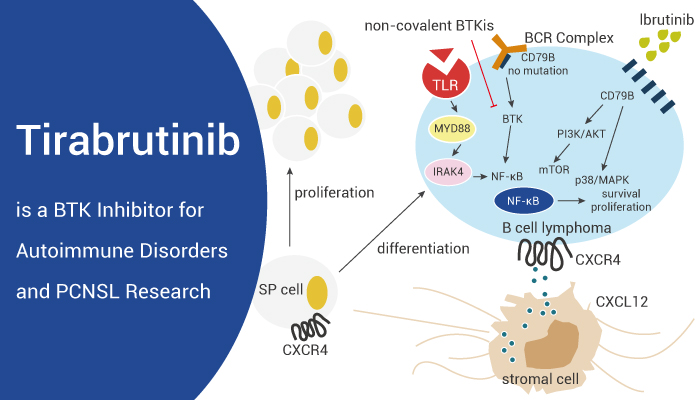Bruton’s tyrosine kinase (BTK) is a key regulator of the B-cell receptor signaling pathway, and aberrant B-cell receptor (BCR) signaling has been implicated in the survival of malignant B-cells. However, BCR signaling has been implicated in the pathogenesis of some B-cell malignancies. Because, the BCR is associated with CD79A/B, and it serves as a receptor to antigens to promote growth, proliferation, and survival of both normal and malignant B-cells. So, whether BTK inhibitor can potently inhibit BCR-related diseases? Hence, we will introduce Tirabrutinib (ONO-4059), a potent BTK inhibitor.
Tirabrutinib is an orally active BTK inhibitor (IC50 = 6.8 nM).
Tirabrutinib can cross the blood-brain barrier (BBB). Also, Tirabrutinib irreversibly and covalently binds to BTK and inhibits aberrant B cell receptor signaling. Moreover, there are studies showed that Tirabrutinib has good activity to inhibit primary central nervous system lymphoma (PCNSL) in clinical trials. Besides, PCNSL is an aggressive lymphoma confined to central nervous system.
In vitro, Tirabrutinib (0.1-1000 nM or 0.001-100 nM; 72 h) inhibits the proliferation of OCI-LY10 and SU-DHL-6 cells with IC50s of 9.127 nM, and 17.10 nM, respectively. In addition, Tirabrutinib (0.5, 5, 50 μM; 24, 48 h) induces SU-DHL-6 cells apoptosis needs high dosage and prolonged administration (concentration up to 50 μM and incubates for 48 h). Besides, Tirabrutinib (300 nM, 72 h) induces caspase-3 and PARP cleavage in TMD8 cells.
In vivo, Tirabrutinib (10 mg/kg; p.o.; single) is rapidly absorbed into plasma and brain, and reaches Cmax (blood Cmax =339.53 ng/mL; brain Cmax =28.9 ng/mL) 2 hours post administration. Moreover, Tirabrutinib (6, 20 mg/kg; p.o.; single daily for 3 weeks) shows inhibition of tumour growth in mice.
Together, Tirabrutinib is a promising BTK inhibitor for autoimmune Disorders and cancer research.
Reference:
[1] Yu H, et al. Transl Cancer Res. 2021 May;10(5):1975-1983.
[2] Kozaki R, et al. Cancers (Basel). 2018 Apr 23;10(4):127.
[3] Liclican A, et al. Biochim Biophys Acta Gen Subj. 2020 Apr;1864(4):129531.
